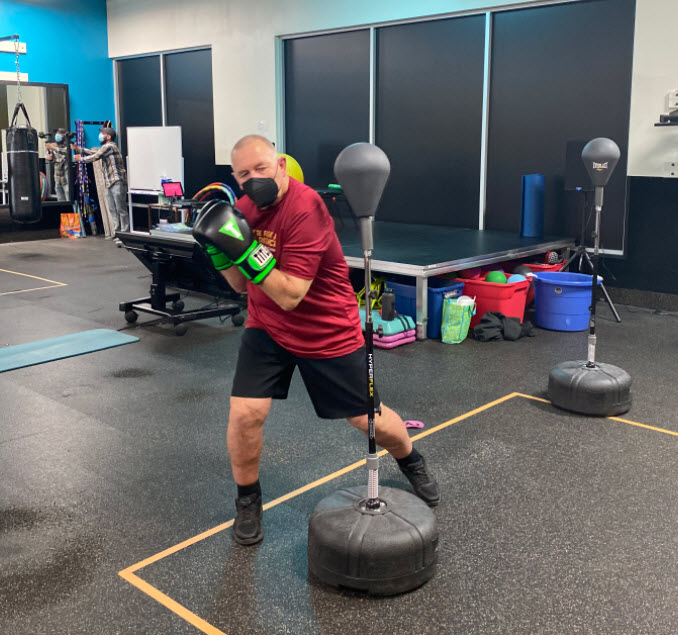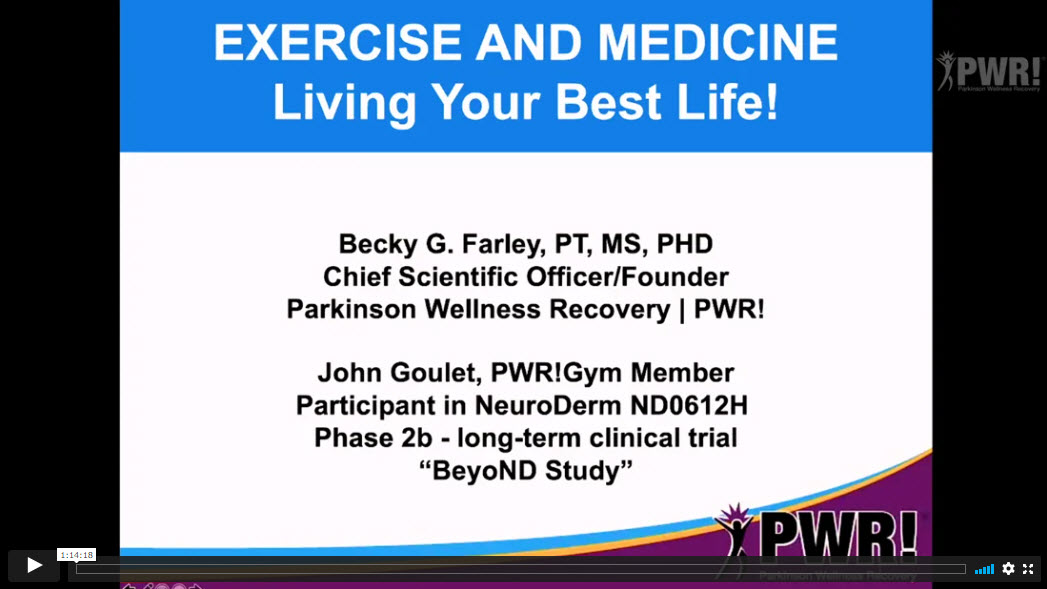Research Update – Strength Guided Plan
To get the most out of your strength-training routines, you need to work at your full cognitive and physical potential. You can get better at what you practice by integrating real-world complexity into your exercise! Read ahead as Dr. Becky Farley, PhD, MS, PT shares the research behind how you can get stronger and fight bradykinesia in everyday life.
Everyone needs to be strong and powerful – but that is particularly true for persons with Parkinson disease (PWP). By definition, bradykinesia interferes with your ability to generate adequate muscle forces to produce big and fast movements1,2. These force deficits are most evident during everyday movements where you need to navigate complex environments. Over time, this results in a loss of voluntary strength (i.e., muscle weakness) and a loss of power (i.e., slow and small movements).
Fortunately, there are two different modes of strength training that can help - high resistance training and power training3-4. Both modes of strength training involve exerting force against a load (e.g., machines, free weights, elastic band, or body weight).
- High resistance training involves exerting forces to move as much weight as possible (high resistance, low velocity).
- Power training involves exerting forces to move as much weight as possible in the shortest period of time (low resistance, high velocity).
Studies in PWP have shown that both modes of strength training are effective at making muscles stronger, including legs, arms, hands and even respiratory muscles4-9! However, power training (i.e., high repetition of bigger and faster movements) may be more effective at overcoming the symptoms of bradykinesia than high resistance training2-3,5,10. Once you are stronger and more powerful, you can integrate that increased strength and speed capability in complex environments like what you encounter in your everyday life.
Now, researchers are looking to see how a person with Parkinson disease can best incorporate their strength in progressively more complex environments 11-12, including with cognitive challenges, and it has taken strength and power training to a new dimension. Results showed that strength training plus cognitive challenge was better than strength training alone.
In other words, while both types of practice make you stronger, adding complex cognitive challenges to your strength routine practice provides MORE benefits, including improved mobility, motor symptoms, and cognition!
Some of the ways you can challenge your cognition and your strength during exercise include:
- Incorporating balance (e.g., varying base of support or surface conditions)
- Challenging working memory (e.g., adding movement sequences or repeating series of words or numbers)
- Activating visual-spatial processing (e.g., changing orientation or positions in space)
- Reducing dependence upon vision (e.g., scan for targets, close eyes).
These are the type of problems your brain has to solve while you are making everyday movements in complex environments. In our new Strength Guided Plan (coming out in April, 2021!) you will have the opportunity to experience these types of strength challenges in the PWR! Virtual Experience via new pre-recorded and live class videos.
Synopsis or Bottom Line
New strength research suggests that working at your full potential physically and cognitively makes you stronger and faster and enables you to better overcome bradykinesia (slow and small everyday movements). This type of real-world fitness practice not only stimulates increased heart rate and blood flow to the brain for brain health; but it reinforces and rebuilds the neural connections and circuitry you need for negotiating complex environments in everyday life.


Our goal is to make sure you’re always empowered and informed.
We offer handouts, downloads, research updates, Wellness Series talks, retreats with knowledgeable speakers, in-person and virtual wellness consultations, and in-person physical therapy visits. We are here for our PWR! Members every step of the way.
We’re excited to have you join us!
Ready to work on your Strength?
Join our Membership and access the Strength Guided Plans!
References
- Farley, B. G., & Koshland, G. F. (2005). Training BIG to move faster: the application of the speed-amplitude relation as a rehabilitation strategy for people with Parkinson’s disease. Experimental Brain Research. 167(3), 462–467. https://doi.org/10.1007/s00221-005-0179-7
- Ni, M., Signorile, J. F., Balachandran, A., & Potiaumpai, M. (2016). Power training induced change in bradykinesia and muscle power in Parkinson’s disease. Parkinsonism & Related Disorders, 23, 37–44. https://doi.org/10.1016/j.parkreldis.2015.11.028
- Cherup, N. P., Buskard, A. N. L., Strand, K. L., Roberson, K. B., Michiels, E. R., Kuhn, J. E., Lopez, F. A., & Signorile, J. F. (2019). Power vs strength training to improve muscular strength. Experimental Gerontology, 128(110740). https://doi.org/10.1016/j.exger.2019.110740
- Lima, L. O., Scianni, A., & Rodrigues-de-Paula, F. (2013). Progressive resistance exercise improves strength and physical performance in people with mild to moderate Parkinson’s disease: a systematic review. Journal of Physiotherapy, 59(1), 7–13. https://doi.org/10.1016/S1836-9553(13)70141-3
- Paul SS, Canning CG, Song J, Fung VS, Sherrington C. Leg muscle power is enhanced by training in people with Parkinson’s disease: a randomized controlled trial. Clin Rehabil 2014;28:275-88.
- Corcos, D. M., Robichaud, J. A., David, F. J., Leurgans, S. E., Vaillancourt, D. E., Poon, C., Rafferty, M. R., Kohrt, W. M., & Comella, C. L. (2013). A two-year randomized controlled trial of progressive resistance exercise for Parkinson’s disease. Movement Disorders, 28(9), 1230–1240.
- Dibble, L. E., Hale, T. F., Marcus, R. L., Gerber, J. P., & LaStayo, P. C. (2009). High intensity eccentric resistance training decreases bradykinesia and improves quality of life in persons with Parkinson’s disease: A preliminary study. Parkinsonism & Related Disorders, 15(10), 752–757. https://doi.org/10.1016/j.parkreldis.2009.04.009
- Pitts, T., Bolser, D., Rosenbek, J., Troche, M., Okun, M. S., & Sapienza, C. (2009). Impact of expiratory muscle strength training on voluntary cough and swallow function in Parkinson disease. Chest, 135(5), 1301–1308. https://doi.org/10.1378/chest.08-1389
- Mateos-Toset, S., Cabrera-Martos, I., Torres-Sánchez, I., Ortiz-Rubio, A., González-Jiménez, E., & Valenza, M. C. (2016). Effects of a Single Hand-Exercise Session on Manual Dexterity and Strength in Persons with Parkinson Disease: A Randomized Controlled Trial. PM and R, 8(2), 115–122. https://doi.org/10.1016/j.pmrj.2015.06.004
- Ni, M., Signorile, J. F., Mooney, K., Balachandran, A., Potiaumpai, M., Luca, C., Moore, J. G., Kuenze, C. M., Eltoukhy, M., & Perry, A. C. (2016). Comparative Effect of Power Training and High-Speed Yoga on Motor Function in Older Patients With Parkinson Disease. Archives of Physical Medicine and Rehabilitation, 97(3), 345-354.e15. https://doi.org/10.1016/j.apmr.2015.10.095
- Kelly, N. A., Ford, M. P., Standaert, D. G., Watts, R. L., Bickel, C. S., Moellering, D. R., Tuggle, S. C., Williams, J. Y., Lieb, L., Windham, S. T., & Bamman, M. M. (2014). Novel, high-intensity exercise prescription improves muscle mass, mitochondrial function, and physical capacity in individuals with Parkinson’s disease. Journal of Applied Physiology, 116(5), 582–592. https://doi.org/10.1152/japplphysiol.01277.2013
- Silva-Batista, C., Corcos, D.M., Roschel, H., Kanegusuku, H., Gobbi, L.T.B., Piemonte, M.E.P., Mattos, E. C. T., De Mello, M.T., Forjaz, C.L.M., Tricoli, V., & Ugrinowitsch, C. (2016). Resistance Training with Instability for Patients with Parkinson’s Disease. Medicine & Science in Sports & Exercise, 48(9), 1678–1687. https://doi.org/10.1249/MSS.0000000000000945
Dr. Becky Farley About the Author
If you ask her, Dr. Becky Farley will tell you that working with her first client with Parkinson’s almost 20 years ago changed her life and her career, and since then she hasn't stopped changing lives of those living with Parkinson's, in Arizona and the rest of the world. In 2010, she established the PWR!Gym in Tucson and has been offering people with Parkinson disease the PD-specific physical therapy, group exercise, and social engagement they need to get better and stay better. Globally, Dr. Farley supports PWR!’s mission of making cutting-edge PD-specific "exercise as medicine” available to the 10 million people living with PD worldwide, by training healthcare and fitness professionals in the PWR!Moves and the PWR!4Life model (and she’s trained over 6000 professionals since she started in 2010!).
When she’s home in Arizona, you’ll find Becky working on PD-specific exercise at the PWR!Gym as well as leading our annual exercise intensive PWR! Retreats. When she’s on the road, she’s either teaching our PWR!Moves workshops or giving talks at conferences, community organizations, and healthcare networks across the US and world.
When she isn’t working, you can find her working out, walking the dog, and gardening. To learn even more about Dr. Farley, visit our team page.

You can find Dr. Farley at:
